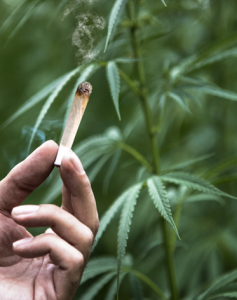2019 marks the first year that cannabis is legal in Canada on April 20 (aka "420"). Before you consume, here's what you need to know to make informed choices.
To make informed choices, we need reliable and credible scientific evidence. This applies when we make important personal choices, such as the choice to consume a legal drug. While we have limited evidence, this article will tell you what we do know about the effects of cannabis and the steps you can take to stay safe.
What is Cannabis?
Cannabis (Cannabis sativa) has many names, including marijuana, weed, pot and the devil’s lettuce. Schedule 1 of Canada’s Cannabis Act defines cannabis as "[a]ny part of a cannabis plant [...] other than a part of the plant referred to in Schedule 2." This plant contains cannabinoids that have psychological and physiological effects. While over 100 cannabinoids have been identified, the two main cannabinoids are:

- Delta-9-tetrahydrocannabinol, also called THC. This is the primary psychoactive compound in cannabis that causes intoxicating effects.
- Cannabidiol, also called CBD. This has fewer psychoactive effects than THC. CBD creates a feeling of wellness without the mind-altering effects of THC. In fact, when the percentage of CBD is higher than that of THC, some research shows it may block the effects of THC. Cannabidiol appears to reduce pain and anxiety.
What's changed?
Like many things in our world branded as new and improved, cannabis has changed over the years. In 1980, THC concentrations were approximately 3%. Due to advancements in growing technology and extraction techniques, concentrations of THC today can vary from 30% to 95%.
What hasn't changed?
What has not changed are the effects of cannabis. People who report “being high” on cannabis describe feelings of:
- Euphoria
- Relaxation
- A sense of well-being
- Alterations in perception
- Time distortion
- Intensified sensory experiences (e.g. sight, taste, smell and sound).
Larger dosages can also cause anxiety, fear, paranoia, confusion, delusions, hallucinations, agitation and disorientation.
Reduce Your Risk
Abstinence is a choice you can make. As with any risky behaviour, the best way to reduce risk is to avoid the behaviour altogether.
If you decide to use cannabis, recognize there can be serious and/or long-term negative health outcomes. We've included some of the variables that affect the likelihood of adverse health outcomes.
Age at first use
The younger the age someone uses cannabis for the first time, the higher the health risks. This is especially true for those under 16 years of age. Young users are more likely to develop related mental health, education and other substance use problems. They are also more likely to experience general injuries. It has to do with the young developing brain, which is not complete till the mid-20s. The Canadian Paediatric Society has issued a Position Statement on "Cannabis and Canada's children and youth" advising against the use of cannabis in youth.
Levels of THC
 Cannabis products vary in their levels of THC. Higher concentrations of THC correlate with increased serious and long-term health effects such as mental health problems, substance dependence or general injuries. Choose products with lower levels of THC.
Cannabis products vary in their levels of THC. Higher concentrations of THC correlate with increased serious and long-term health effects such as mental health problems, substance dependence or general injuries. Choose products with lower levels of THC.
Method of consumption
- Smoking can result in various pulmonary-bronchial problems, including lung cancer. Smoking is likely the most hazardous form of consumption.
- Vaping or e-cigarette devices reduce key health risks related to smoking, but are not risk free.
- Edible products do not have inhalation risks. This method delays the onset of psycho-active effects and can lead to overdosing.
Co-use with alcohol
Cannabis combined with alcohol can lead to greater impairment of cognitive and motor skills than taking either substance alone. When people consume cannabis and alcohol at the same time, the amount of THC in their blood is higher than if they consume cannabis on its own. They also tend to take higher quantities of both, which leads to greater levels of impairment. Do not consume cannabis and alcohol at the same time.
Cannabis and driving
Like alcohol, cannabis negatively affects a person’s driving ability. These intoxicating effects include:
- Decreased ability to track moving objects
- Slower reaction time
- Changed visual function
- Impeded ability to concentrate
- Diminished short-term memory
- Reduced ability to divide attention
These effects cause variability in driver behaviours such as following distance, speed and lane position. If caught driving under the influence of cannabis you will be charged with impaired driving. For more information see AGLC's Cannabis Facts.
Safety Beyond Impaired Driving
Accidental poisoning
 After the state of Colorado legalized recreational cannabis, unintentional exposure to cannabis by children aged 0 to 9 increased more than five times. While the numbers were small (nine in 2005 and 47 in 2015), 15% of cases were admitted to an intensive care unit. Almost half (48%) of these cases involved edible cannabis products such as cookies, brownies, cake, candies and popcorn. Edibles will be commercially available in Alberta by October 17, 2019. Yet, homemade edible products containing cannabis can be in kitchens right now. Colorado's experience suggests that cases of children ingesting cannabis will increase in Alberta. Parents and caregivers need to remember to store cannabis as they would any other medication – in a locked box high up and out of the reach of children. If it is a commercially produced product, keep it in its original packaging.
After the state of Colorado legalized recreational cannabis, unintentional exposure to cannabis by children aged 0 to 9 increased more than five times. While the numbers were small (nine in 2005 and 47 in 2015), 15% of cases were admitted to an intensive care unit. Almost half (48%) of these cases involved edible cannabis products such as cookies, brownies, cake, candies and popcorn. Edibles will be commercially available in Alberta by October 17, 2019. Yet, homemade edible products containing cannabis can be in kitchens right now. Colorado's experience suggests that cases of children ingesting cannabis will increase in Alberta. Parents and caregivers need to remember to store cannabis as they would any other medication – in a locked box high up and out of the reach of children. If it is a commercially produced product, keep it in its original packaging.
Burns
After Colorado approved the use of medical marijuana in 2008, incidents of hydrocarbon burns caused by the extraction of hash oil from cannabis started to occur. Nineteen cases were reported between 2008 and 2013. An additional twelve cases were reported within the first eight months of legalization in 2014. While the number of cases reported were small, the hydrocarbon flash burns that resulted from explosions and fires were serious, debilitating and costly.
Other injuries
Cannabis impairs the following skills needed for many sports and recreational pursuits, such as:
- Reaction time
- Information processing
- Perceptual-motor coordination
- Motor performance
- Attention
- Tracking behaviour
Because cannabis is likely to impair these abilities, it may contribute to increased rates of injury.
To know more about the risks to your health from using cannabis please refer to Canada’s Lower-Risk Cannabis Guidelines.



Add a comment to: Where’s the Smoke? Understanding Your Choices About Cannabis